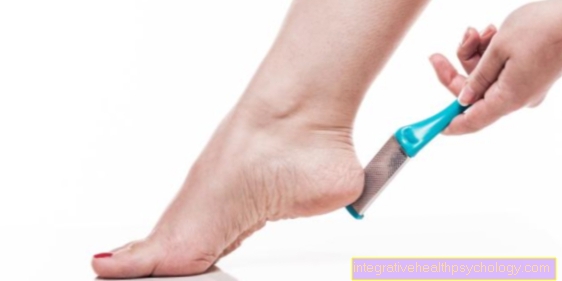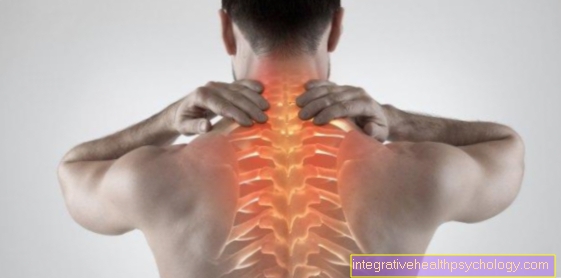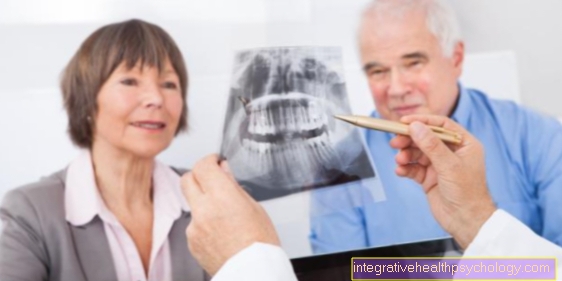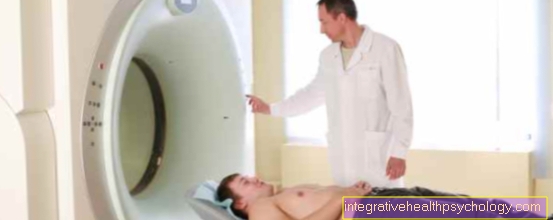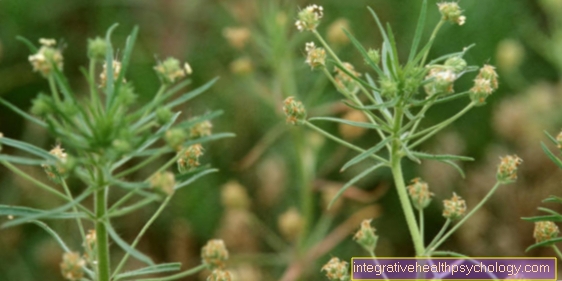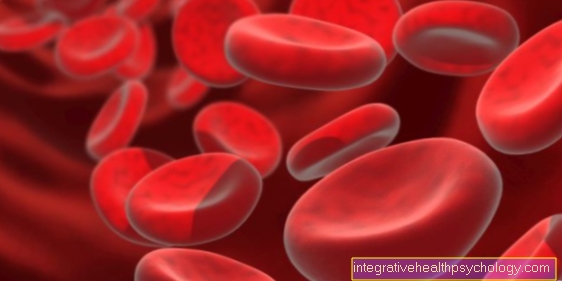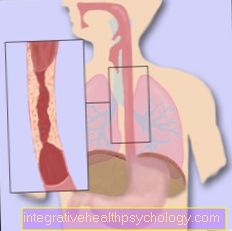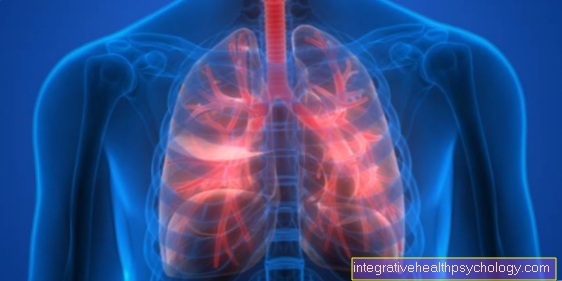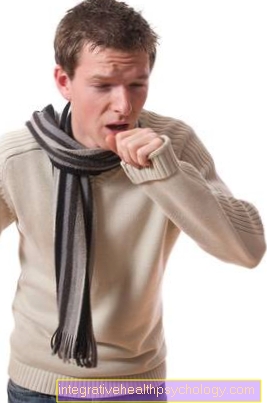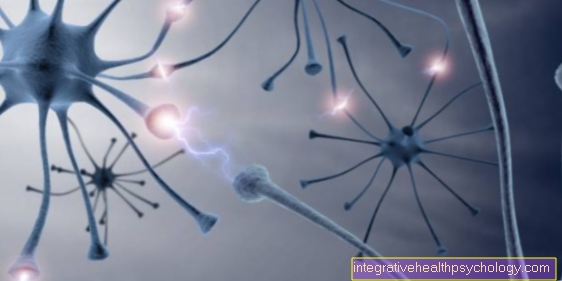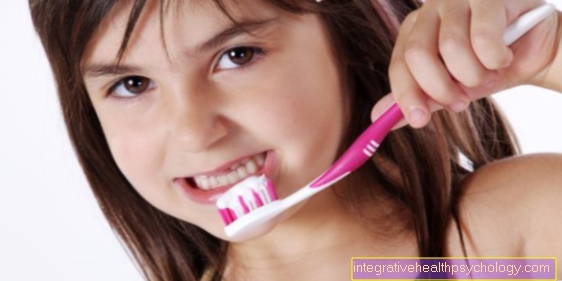Injury in bodybuilding
- Shoulder joint
- Rotator cuff
- wrist
- Carpal tunnel syndrome
- Pelvis / thigh
- Muscle injury
Tendinitis- Inguinal hernia
- Knee joint
- Ankle joint
Synonyms in a broader sense
Weight training, weight training, weight lifting, body fitness, fitness, power lifting
introduction
This topic is aimed at all athletes who build muscle with weights.
Accidental injuries are rare in bodybuilding. In the foreground are injuries to muscles and tendons due to incorrect or overloading.

Possibility of injury to the arms (upper extremity)
The upper extremity (arms / Arm muscles) is particularly often affected by injuries. Both the shoulder and that Elbow joint and the wrist are affected by injuries.
Shoulder joint
Rotator cuff
In the area from Shoulder joint predominate complaints of Rotator cuff. The is of particular interest for muscle and tendon diseases of the shoulder Supraspinatus tendon, which is often 50% stronger in bodybuilders than in the general population. The supraspinatus muscle lies on the upper part of the shoulder blade and pulls under the shoulder roof to the humerus head, where it attaches with its sinewy end. The function of the Supraspinatus muscle is the lateral lifting of the arm, especially during the start phase when the hands are still resting on the side of the thigh. Overloading the tendon attachment during training can lead to chronic inflammation (supraspinatus tendon tendinitis / tendinosis). A typical exercise for this is the lateral elevation (abduction) of the extended arm with the dumbbell or a cable pull. Other exercises that primarily require an external turning movement of the arm can also lead to a tendon attachment disease of the rear parts of the rotator cuffs (infraspinatus muscle, teres minor muscle).
For more information, see:
- Rotator cuff tear
- Rotator cuff
Impingement syndrome
The muscle growth of the supraspinatus muscle can also lead to a tightness in the shoulder roof area (subacromial space). When the arm is lifted, the supraspinatus can strike under the roof of the shoulder (impingement syndrome) and, with frequent repetition, lead to inflammation of the bursa that is also located there (subacromial busitis). An unbalanced shoulder musculature with a predominance of the deltoid muscle can support this effect, because the "deltoideus" tends to pull the upper arm upwards and additionally reduce the shoulder roof width. In the worst case, chronic irritation of the supraspinatus tendon can develop into a rotator cuff tear.
This also plays a role for instability simpingement. Here, the head of the humerus tends to be pressed forward again and again against the anterior joint capsule, which expands and creates an unnoticed anterior shoulder instability. As a result of this instability, the humerus head can slide more often and lead to entrapment in the shoulder roof area. Exercises that promote instability simpingement are the neck press behind the head, the lats pulling into the neck, covers and so-called flies (a chest muscle training in which the athlete lies on his back and moves his arms up and down).
The pain in the impingement syndrome is in the area of the lateral shoulder and often radiates into the lateral upper arm.
In the area of the shoulder joint (acromioclavicular joint), there is irritation caused by overload. The pain point is in the side / upper shoulder area. The joint is particularly stressed when the arm is raised to the side, when the upper arm almost touches the ears. Moving the arm horizontally to the opposite side is particularly painful. Here, too, the joint is particularly stressed and pain is provoked. Chronic overloading of this joint can result in early osteoarthritis or bone dissolution (osteolysis) of the lateral end of the collarbone. The symptoms are particularly caused by the classic bench press. In advanced cases, the lateral end of the collarbone must be surgically removed.
A tendon or muscle tear are relatively rare occurrences and are based on previous degenerative damage to the tendon or extreme overloading of the muscle. In the shoulder area, the long biceps tendon (biceps muscle, caput longum) can tear. The long biceps tendon in the shoulder joint tears off and the muscle belly of the biceps muscle slips down the front of the upper arm towards the elbow. Sudden shoulder pain occurs and when the biceps muscle is tensed, the muscle belly that has slipped down becomes noticeable on the upper arm. The muscle strength of the "biceps" is largely preserved due to the function of its second origin (short head) on the coracoid.
For more information, see:
- Impingement syndrome
- Rotator cuff
- Biceps tendon
- Torn hamstring shoulder
- Torn muscle fibers in the chest
- Torn muscle fiber of the forearm
Elbow
The so-called tendon attachment diseases (med. Synonyms: insertion tendinopathy, insertion tendinosis, enthesopathy), which are caused by tensile loads on the tendons surrounding the elbow joint, are predominantly found on the elbow joint.
Tennis elbow and golfer's elbow
This includes tennis elbow (epicondylitis humeri radialis), which of course does not refer to the sport that gives it its name, but rather describes the tendon disease of the forearm extensor muscles on the humerus (epicondylus humeri radialis). A clinical picture that is often found in tennis players, hence the name.
The epicondyle and thus also the pain point are located at the end of the lateral upper arm on a rounded, raised bone protrusion that can be easily felt. This is where the forearm extensor muscles come in. Pain at this point moves towards the extensor forearm and is provoked and entertained by the extension in the wrist. The main exercise causing discomfort is above all the biceps curl with the long bar. Here, the wrist is turned maximally outwards (palm up, supination), which causes the forearm extensor muscles to pull in an unfavorable direction. A curved barbell would be better, where a better grip position can be assumed and the maximum supination of the forearm is avoided during the exercise.
In the same way there is the disease at the attachment of the forearm flexor muscles at the epicondylus humeri ulnaris (epicondylitis humeri ulnaris = golfer's arm). The pain point can be found by moving the inner upper arm down towards the elbow joint. Here, too, the epicondyle is easy to feel as a rounded, raised bone protrusion. Pain in this area will include Caused by exercises with the straight bar in pronation position (palms facing the floor).
For more information, see:
- Tennis elbow
- Symptoms of tennis elbow
and - Golfer's elbow
Inflammation of the tendons (enthesopathy)
The attachment tendinosis of the triceps muscle (triceps) is found on the back of the elbow. The symptoms are mainly caused by the triceps press, the tight bench press and the forehead press. Here, too, the straight bar plays an important role in the development of pain, but an improperly executed movement with maximum extension of the elbow joint in the end phase can be responsible for the symptoms. In extreme cases, the triceps tendon can tear.
You can find more information about correct execution under our topics:
- Triceps extension
- Bench press
Pain in the area of the attachment of the biceps tendons (enthesopathy of the attachment of the biceps) in the area of the upper radius bone is caused by excessive strain (excessive weight). In extreme cases, the biceps tendon can tear at this point. There is then the indication for surgical fixation of the tendon (refixation). Pain exists in the depths of the flexor-side and thumb-side elbow joint. Full extension of the elbow joint should also be avoided during biceps exercises.
wrist
In the wrist area, tendon sheath inflammation (tendovaginitis) of the flexor or extensor muscles predominates, as well as symptoms of overuse of the wrist due to extreme hyperextension of the wrist, such as the bench press. The tight bench press can damage the triangular disc (cartilage disc on the side of the spoke in the wrist).
Carpal tunnel syndrome
Overloading the wrist, tendinitis or prolonged stretching of the wrist can cause symptoms of carpal tunnel syndrome. These include wrist pain and fingers 1-3 falling asleep.
For more information, see:
- Carpal tunnel syndrome
Injuries to the lower extremities (legs)
Pelvis / thigh
These are mostly tendon attachment disorders, muscle strains or blockages of the sacrum and iliac joint (sacroiliac joint, SI joint).
Muscle injury
Many strength athletes, especially beginners, tend to start training unwarmed. However, cold muscles are less flexible and resilient, which is why muscle strains or even muscle fiber tears can easily occur. The adductor muscles, the anterior thigh muscles (especially the rectus femoris muscle) and the rear thigh muscles (especially the biceps femoris muscle) are affected by injuries. The athlete feels a stitch-like pain with a subsequent cramp-like muscle feeling. The initial measures are based on the PECH scheme (break, ice, compression, elevation).
For more information, see:
- Muscle strain
- Behavior after sports injury
- Stretching
Tendinitis
The same muscles can also cause insertion tendons on the pelvic ring. These include pain in the ischium (buttocks), in the front (rectus femoris muscle) and inner groin region (adductors).
Inguinal hernia
Groin pain can also be caused by a hernia (inguinal hernia). Hernias of any kind, whether in the area of the groin or the abdominal wall, occur particularly during exercises with a strong increase in internal abdominal pressure (intra-abdominal pressure). These include abdominal muscle training, leg presses or squats.
You can find further information under our topic: Inguinal hernia.
Blockage of the sacroiliac joint
Evasive movements with maximum exertion or improperly performed exercise can block the sacroiliac joint (ISG) or misalign the sacrum. The complaints are often localized in the upper buttock area and can radiate into the groin and thighs. Most misalignments and blockages can be treated well with manual therapy, possibly supported by infiltration, heat treatments and drug pain therapy.
Read more on this topic at: Blockage of the sacroiliac joint
Knee joint
A meniscus tear or even a cruciate ligament tear are very rare occurrences and not typical for bodybuilding.
A common cause of knee pain is femoropatellar overuse pain (chondromalacia), which can be caused by squats in particular. During the squat, the kneecap (patella) is pressed against its sliding surface (femoropatellar sliding bearing). The more the knee joint is bent, the greater the contact pressure. The kneecap cartilage suffers from this pressure. It is therefore advisable neither to bend the knees too much during leg exercises, nor to fully extend the knee joint on the leg machine.
Otherwise, attachment tendons also occur in the knee joint area. The quadriceps tendon at the upper kneecap attachment and the patellar tendon (patellar tendon) at the lower kneecap attachment (patellar tip syndrome) are often affected.
For more information, see:
- Meniscus tear
- anterior cruciate ligament tear
- posterior cruciate ligament tear
- Knee osteoarthritis
- Patellar tip syndrome
Ankle joint
Discomfort in the ankle joints and feet are very rare and then usually caused by trauma, for example from an twisted ankle or a falling weight.
Therapeutic measures
Prophylaxis is still the best therapy.
Prophylaxis includes good training equipment, proper warm-up, stretching / stretching of the muscles and mastering the equipment used. That is why it is especially important for beginners to have sensible advice, with an explanation of the equipment, handling of the equipment, discussion of the objectives of the training and the creation of an individual therapy and, if necessary, nutrition plan.
If you already have complaints, you should reduce the scope of training or take a break from training. It should be critically examined which exercises are causing the discomfort. Possibly. only the exercise has to be adjusted, but if necessary a substitute exercise has to be found.
NSAIDs (non-steroidal anti-rheumatics) are temporarily suitable for pain therapy, in consultation with the doctor, targeted infiltrations and physiotherapeutic and physical therapy. To treat the frequent attachment tendons, they do their own stretching exercises and friction massages during physiotherapy (physiotherapy). Of the physical therapy measures, a heat treatment and, in acute phases, a cold treatment, as well as ultrasound therapy, shock wave treatment, and various current applications are successful. Functional orthoses ("bandages"), tapes, etc. can be used in the meantime. However, starting exercise too early will ruin any attempt at therapy. This is especially true for the frequent attachment tendencies, the symptoms of which tend to become chronic.
A doctor, if possible an orthopedist and sports physician, should be consulted for any longer-lasting symptoms.
Note
In the event of unclear complaints, we would like to refer to our Diagnostic refer. On the basis of your complaints and symptoms, you can use our diagnostic tool to diagnose your disease.
Other topics of interest:
- Strength training
- Muscle building
- Injury deadlift



